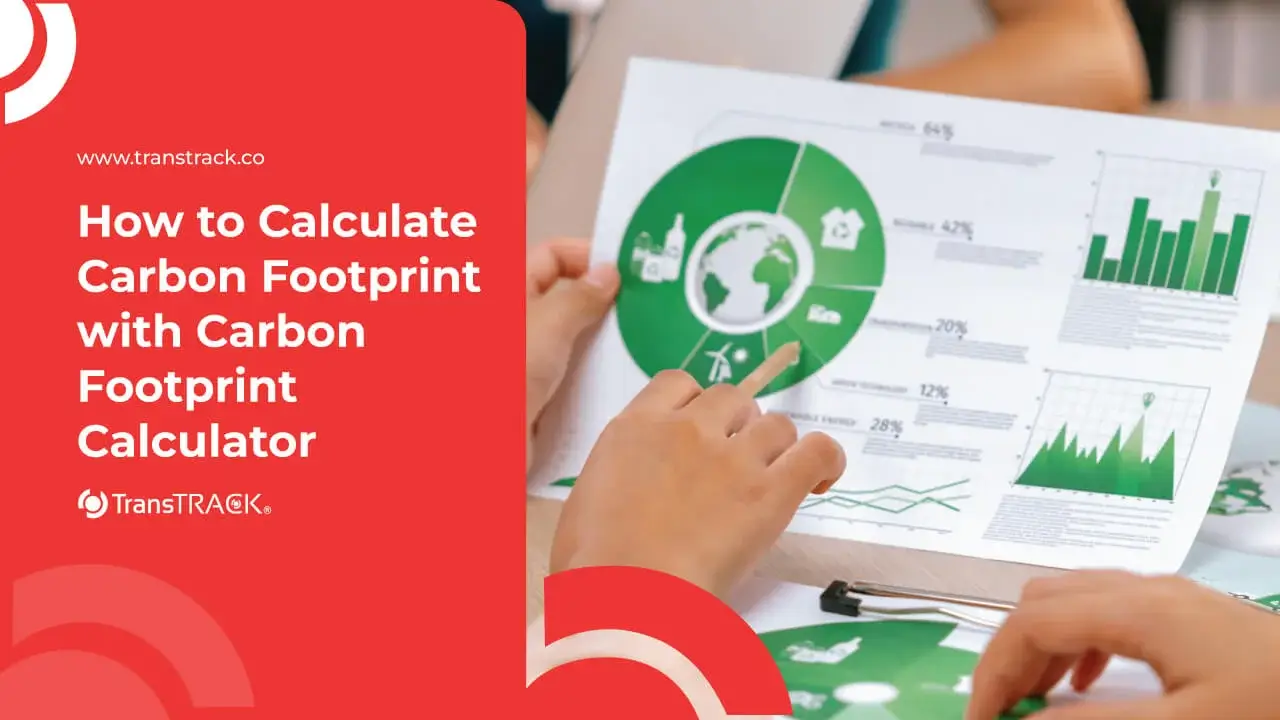How to Calculate Carbon Footprint with Carbon Footprint Calculator
Posted on March 6, 2025 by Nur Wachda Mihmidati

Carbon footprint calculator is a tool that helps individuals and companies measure greenhouse gas emissions from various activities, such as vehicle usage and energy consumption. By understanding the carbon footprint, concrete steps can be taken to reduce emissions and improve operational efficiency. This article TransTRACK will discuss the types of carbon calculators, how they work, and their benefits in supporting sustainability, especially in the transportation and logistics sector.
Why is calculating carbon footprint important?
Calculating our carbon footprint is important to understand the environmental impact of our activities. By measuring our carbon footprint, we can:
- Reduce the Impact of Climate Change: Identify and reduce greenhouse gas emissions that cause global warming.
- Improving Energy Efficiency: Finding ways to save energy and fuel.
- Meeting Regulations: Comply with environmental regulations and avoid sanctions.
- Improves Business Reputation: Helps companies demonstrate commitment to sustainability.
- Drive Innovation: Develop environmentally friendly and efficient solutions.
Calculating our carbon footprint is an important step for sustainability and operational efficiency.
How to Calculate Carbon Footprint?
Calculating the carbon footprint of a vehicle can be done with the following steps:
1. Identify Fuel Consumption per Kilometer
- Record the amount of fuel consumed in liters or kilograms.
- Calculate the vehicle mileage in kilometers.
- Use the basic formula:
2. Convert Fuel Consumption to CO₂ Emissions
Use standard emission factors issued by environmental agencies or international organizations. Examples of emission factors for some fuels:
- Gasoline: 2.31 kg CO₂ per liter
- Solar (Diesel): 2.68 kg CO₂ per liter
- LPG: 1.51 kg CO₂ per liter
Emission calculation formula:
3. Incorporating Other Factors
Besides fuel consumption, there are other factors that affect total carbon emissions:
- Vehicle load: The heavier the load, the more fuel consumed.
- Idle time (time idling with the engine running): Vehicles that frequently stop with the engine running still produce emissions.
- Engine type and vehicle technology: Vehicles with more efficient engines will produce lower emissions.
4. Analyzing Results and Identifying Emission Reduction Opportunities
After obtaining the total emissions, conduct an analysis to find ways to reduce the carbon footprint, such as:
- Travel route optimization to avoid congestion and unnecessary mileage.
- Reducing idle time by implementing an engine-off policy during long stops.
- Use of more efficient fuels, such as diesel biodiesel or electricity.
- Regular vehicle maintenance to improve fuel efficiency.
With this approach, we can effectively measure, analyze and reduce vehicle carbon emissions, supporting environmental sustainability and operational efficiency.
How the Carbon Footprint Calculator Works
Carbon Footprint Calculator is a tool that calculates the amount of carbon emissions produced by an activity, such as vehicle use, electricity consumption, or industrial processes. Here is how it works:
1. Input Data Collection
Users input data related to activities that produce carbon emissions, such as:
- Vehicle: Fuel type, fuel consumption per kilometer, mileage, idle time.
- Electricity: Total electricity consumption (kWh) and energy source (PLN, solar power, etc.).
- Industry: Type of fuel used in production, amount of waste generated.
- Consumption pattern: Plastic use, food, or traveling habits (plane, train, etc.).
2. Data Conversion to CO₂ Emissions
The data entered is then converted into CO₂ emission amounts using standard emission factors. Each fuel or energy source has a different emission factor.
Example calculation for vehicles:
3. Calculation of Total Carbon Footprint
After calculating the emissions from each source (vehicles, electricity, industry, etc.), the results are summed up to get the total carbon footprint of an individual or company.
4. Emission Reduction Analysis and Recommendations
Based on the calculation results, the calculator will provide:
- Evaluation of total emissions and comparison with global or national standards.
- Emission reduction recommendations, for example:
- Reducing the use of private vehicles and switching to public transportation.
- Using renewable energy or improving electricity efficiency.
- Reducing plastic waste and consumption of products with a high carbon footprint.
5. Reporting and Monitoring Changes
Many carbon footprint calculators feature historical tracking, allowing users to monitor changes in emissions over time and evaluate the effectiveness of reduction measures taken.
Types of Carbon Calculators
Carbon footprint calculators can be categorized based on the scale of use, namely for individuals, vehicles, and logistics companies. Here is the explanation:
1. Carbon Calculator for Individuals
This calculator is used to calculate a personal carbon footprint based on a person’s lifestyle.
Factors Calculated:
- Use of private vehicles and public transportation
- Electricity consumption and energy sources at home
- Diet (meat, dairy, local vs imported food)
- Plastic use and waste production
Outcome: Total individual carbon emissions in units of kg CO₂ per year and recommendations to reduce them.
Example of Use: Someone wants to know the carbon impact of their daily routine and find ways to be more environmentally friendly, for example by reducing air travel or switching to an electric vehicle.
2. Carbon Calculator for Vehicles
This calculator is used to measure the carbon emissions produced by vehicles based on fuel consumption.
Calculated Factors:
- Vehicle type (car, motorcycle, truck, bus, etc.)
- Fuel type (gasoline, diesel, electricity, biodiesel, etc.)
- Fuel consumption per kilometer
- Vehicle mileage
- Idle time (time the engine is running without moving)
Results: Total vehicle emissions in kg CO₂/km or per trip as well as tips to improve fuel efficiency.
Example of Use: Vehicle owners want to know how much CO₂ emissions are generated each month based on fuel consumption and find ways to save fuel.
3. Carbon Calculator for Logistics Companies
This calculator is used to measure and manage the carbon footprint generated by a company’s logistics fleet and operations.
Factors Calculated:
- Type and number of vehicles in the logistics fleet
- Fuel consumption per unit and total fleet emissions
- Travel routes and logistics optimization
- Fuel type and alternative options (LNG, biodiesel, electricity)
- Vehicle idling time and delivery efficiency
Outcome: Total carbon emissions in ton CO₂ per month/year as well as strategies to reduce emissions through route efficiency, fuel switching, and vehicle maintenance.
Logistics company wants to calculate the total emissions of its delivery fleet and look for solutions to reduce environmental impact, such as using more efficient routes or switching to electric vehicles.
Carbon calculators help individuals and companies measure, understand and reduce carbon emissions more effectively to support environmental sustainability.
Measuring your carbon footprint with the carbon footprint calculator is an important step in reducing greenhouse gas emissions and improving energy efficiency. Whether for individuals, vehicles or logistics companies, this calculator helps in identifying the main sources of emissions and finding more sustainable solutions.

For companies looking to optimize vehicle operations and reduce their carbon footprint, the use of TransTRACK’s Fleet Management System can be the perfect solution. With advanced monitoring technology, TransTRACK allows companies to manage fuel consumption, minimize idle time, optimize travel routes, as well as improve overall fleet efficiency.
Improve the sustainability of your business with greener digital solutions. <Use TransTRACK’s Fleet Management System now and realize more efficient and sustainable operations.
Recent Post
Topic :
Recommended Articles

 Bahasa Indonesia
Bahasa Indonesia







